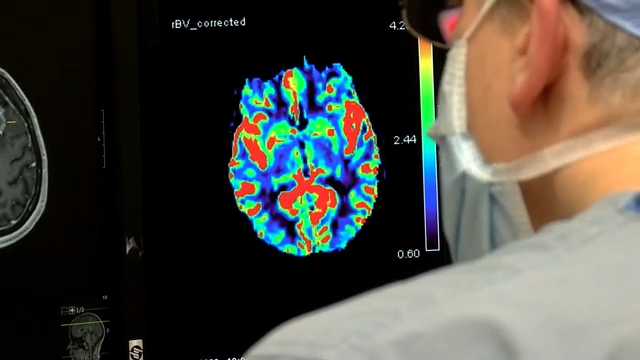LOS ANGELES, Calif. (Ivanhoe Newswire) – It’s the type of brain bleed medical experts say killed comedian Bob Saget in January. A subdural hematoma can happen when someone falls and hits their head or if an aneurysm ruptures. In one in four patients, even after surgery, the brain bleed will return. But there is a new treatment that is keeping brains safe and people alive, IRRAFlow.
Horace Mitchell spent his life in education. With a Ph.D. in Black studies, he went on to teach and run universities, retiring as president of California State University, Bakersfield. But then, a fall in his garage threatened to end it all.
“I ended up falling backwards and I hit my head on the side of the refrigerator,” Mitchell explained.
He was confused and unsteady—sure signs something was wrong. Doctors diagnosed Mitchell with a subdural hematoma, which is a type of brain bleed.
Neurosurgeon Sumeet Vadera said that is when blood accumulates on the surface of the brain. Vadera says traditionally, surgeons would drill a hole into the skull and drain the fluid. But many times, more blood accumulates, and a second surgery is needed. Dr. Vadera is the first to successfully treat a patient using a new system, called IRRAflow.
“During the surgery, you would make a small window in the bone, then, you place a catheter into the area where the blood clot was,” Dr. Vadera explained.
For one to two days after surgery, it continuously irrigates and aspirates the area, draining any excess blood.
“It has actually helped save us from having to put the patient through another surgery,” Dr. Vadera added.
Dr. Vadera says he’s not had any patients, including Mitchell, who needed a second surgery after rehab and physical therapy.
Mitchell says he is doing well physically and mentally following his surgery.
An estimated 6.5 million people in the United States have an unruptured brain aneurysm. A brain aneurysm ruptures every 18 minutes. If a brain bleed is not treated, there is a high risk of stroke and death.
Contributors to this news report include: Marsha Lewis, Producer; Roque Correa, Videographer, Editor.
To receive a free weekly e-mail on medical breakthroughs from Ivanhoe, sign up at: http://www.ivanhoe.com/ftk
Source:
MEDICAL BREAKTHROUGHS
RESEARCH SUMMARY
TOPIC: IRRAflow: SAVING HORACE’S BRAIN
REPORT: MB #5026
BACKGROUND: Intracerebral hemorrhage, or bleeding into the brain tissue, is the second most common cause of stroke, between 15-30% of strokes, and the most deadly. Blood vessels carry blood to and from the brain. Arteries or veins can rupture, either from abnormal pressure or abnormal development or trauma. The blood itself can damage the brain tissue. Furthermore, the extra blood in the brain may increase the pressure within the skull to a point that further damages the brain. Treatment focuses on stopping the bleeding, removing the clot and relieving pressure on the brain. If left alone, the brain will eventually reabsorb the clot. The damage done by increased brain pressure over a long period may be irreversible
(Source: www.aans.org/en/Patients/Neurosurgical-Conditions-and-Treatments
DIAGNOSING: Bleeding in the brain has a number of causes including head trauma caused by a fall, car accident, sports accident or other type of blow to the head. Other causes include
high blood pressure, buildup of fatty deposits in the arteries, blood clot that formed in the brain or traveled to the brain from another part of the body, ruptured cerebral aneurysm, buildup of amyloid protein within the artery walls of the brain, a leak from abnormally formed connections between arteries and veins, bleeding disorders or treatment with anticoagulant therapy, brain tumor that presses on brain tissue causing bleeding, smoking, heavy alcohol use, or use of illegal drugs such as cocaine, conditions related to pregnancy or childbirth, including eclampsia, postpartum vasculopathy, or neonatal intraventricular hemorrhage, and conditions related to abnormal collagen formation in the blood vessel walls that can cause to walls to be weak. If you experience symptoms such as sudden tingling, weakness, numbness, or paralysis of the face, arm or leg, particularly on one side of the body, headache, nausea and vomiting, confusion, dizziness, seizures, difficulty swallowing, loss of vision or difficulty seeing, loss of balance or coordination, stiff neck and sensitivity to light, slurred speech, difficulty reading, writing or understanding speech, changes in level of consciousness or alertness, lack of energy, sleepiness or trouble breathing and abnormal heart rate you may want to get examined by a doctor for bleeding in brain.
NEW RESEARCH: The efficacy and safety of surgical treatment for intracerebral hemorrhage, or ICH, have long been subjects of investigation and debate. The recent results of the minimally invasive surgery plus alteplase for intracerebral hemorrhage evacuation, or MISTIE, III trial demonstrated the safety of the procedure and a reduction in mortality compared to medical treatment. Although no improvement in functional outcomes was shown, the trial suggested those benefits of intervention depend on surgical performance: a greater ICH reduction, defined as less than or equal to 15 mL end of treatment ICH volume or more than or equal to 70 percent volume reduction, correlated with significant functional improvement. Recent meta-analyses suggested the benefits of neurosurgical hematoma evacuation, especially when performed earlier and done using minimally invasive procedures
(Source: https://www.frontiersin.org/articles/10.3389/fneur.2021.703189/full)
FOR MORE INFORMATION ON THIS REPORT, PLEASE CONTACT:
Sumeet Vadera, MD
If this story or any other Ivanhoe story has impacted your life or prompted you or someone you know to seek or change treatments, please let us know by contacting Marjorie Bekaert Thomas at mthomas@ivanhoe.com




